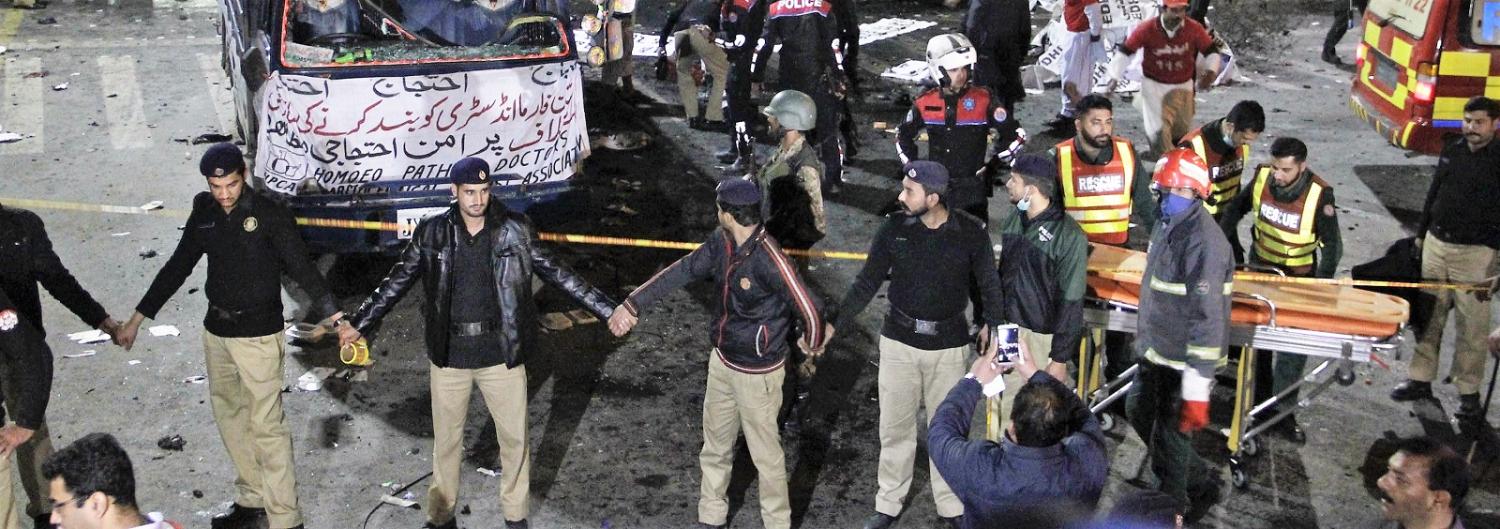It's been some time since I lived on Mall Road near Lahore's busy Mayo Hospital which treats most emergency cases but ambulance sirens still wake me at night, a feature now sometimes of nightmares where I see again the dead bodies and terror victims I have reported on through the years.
On 15 March 2015, for example, there were two blasts at two churches in Youhanabad targeting Catholic and Protestant Christians. The scenes of horror that followed, when the mob burnt alive a man suspected of carrying out the attacks, cannot be erased from memory.
This week brought another terrible first in Lahore; the first time a suicide bomb blast took place at a peaceful gathering of people, rallying to protect their rights. Hundreds of pharmacists were staging a demonstration at Charring Cross in front of Punjab Assembly building when the blast took place at 6.15pm. The damage would have likely been more had the bomber blew himself up in the crowd so perhaps the priority was not maximum loss of live but to target police officers.
Lahore’s Chief Traffic Officer (DIG) Ahmed Mobeen, Senior Superintendent Police Akram Gondal, a traffic warden, two Elite Police Force officers and another from the Dolphin Police Squad were among the 14 people who died on the spot. Close to 100 injured were admitted in hospitals. Six to eight kilos of explosives were used in the blast.
The immediate aftermath was chaotic but police, trained by more than a decade of terror incidents (see timeline) to work in such incidents, were quick to make formations. They proceeded immediately with relief work, disregarding the very real (to judge by past instances) danger of a follow up blast.
There was a lot of blood and body parts. One woman, though not hurt, could not believe what she was seeing and fainted. An emergency was declared across all of the city's hospitals though the majority of victims were taken to nearby Ganga Ram Hospital. There too, there was discipline in the chaos with volunteers from various welfare organisations forming a human chain to ensure clear passage for the injured. There was no incident of mismanagement but many of those whose loved ones were among the injured were angry and they shouted at the city mayor when he arrived.
The next day (Tuesday) a pall of gloom hung over the city. All markets were closed. Attendance at government and private offices was sparse. About half of schools were shut. The traffic on roads was also thin. The blood was washed from the site of bomb blast in the afternoon, after police investigation teams cleared away. The city was grieving the dead and nobody wanted to talk much about it.
Three groups claimed responsibility for the bombing: Tehreek-e-Taliban Pakistan (TTP) - that is Jamaat-ul-Ahrar - TTP (Fazlullah) and a new group called Intikam-e-Waziristan, which means revenge for Waziristan. The Pakistan Army, through operation Zarb-e-Azab, has almost wiped out the terrorists from North and South Waziristan.
The last blast in Lahore took place in a public park on 27 March last year. That was Easter Sunday. Of the 75 people who died, 14 were Christians while the rest were Muslims. Jamaat-ul-Ahrar had claimed responsibility then.
Many people from different walks of life initially thought India was responsible this week's blast for reasons to do with sport which, in one form at least, is close to a religion in this country.
Pakistanis are crazy about cricket. They love the game. However, no international sports events have been held in Pakistan since the attack on Sri Lankan team in March 2009 in Lahore. Right now the Pakistan Super League is underway in UAE. The final of this cricket tournament, in which players of different countries are participating, was to have been held in Lahore after the venue was declared secure by the International Cricket Council. Now that match may be played elsewhere. This is why many Pakistanis thought India was responsible; because it did not want international sports to come to Pakistan. The Pakistan government at different times has accused India of sponsoring terrorism in Pakistan. An alleged Indian spy now in Pakistan custody, Kalbulshan Jadhav, has reportedly admitted to sponsoring terrorism.
Some people believe that the attack was aimed at DIG Mubeen who had served for some time in the Counter Terrorism Department of Police. He could also have been targeted because he is a Shia Muslim. On many occasions the Taliban have attacked the Shia community. If the attack was not just on him but on the police force as a whole that argument may hold some ground. Police have often been targeted. In Lahore the police academy was attacked in 2012 and nine cadets were killed. In 2015 there was a blast near Police Lines in which eight cops were killed.
Terrorism in this city also impacts on its future. Right now, China is investing more than $50 billion in the China Pakistan Economic Corridor scheme. Many projects related to this are already underway, including the Orange Line Metro Train in Lahore. The success of CPEC depends on ensuring security at all points of the corridor in Pakistan. A blast in Lahore could be big blow to attracting Chinese investment.
This week's attack came just few hours after Elite Police Force staged a flag march on city roads. The terrorists' message was clear: people not safe. But I take some comfort from the resolution of the many people I saw on the scene and in the hours after. Pakistanis are determined not to yield to the fear of terrorism.
A decade of terror in Lahore

